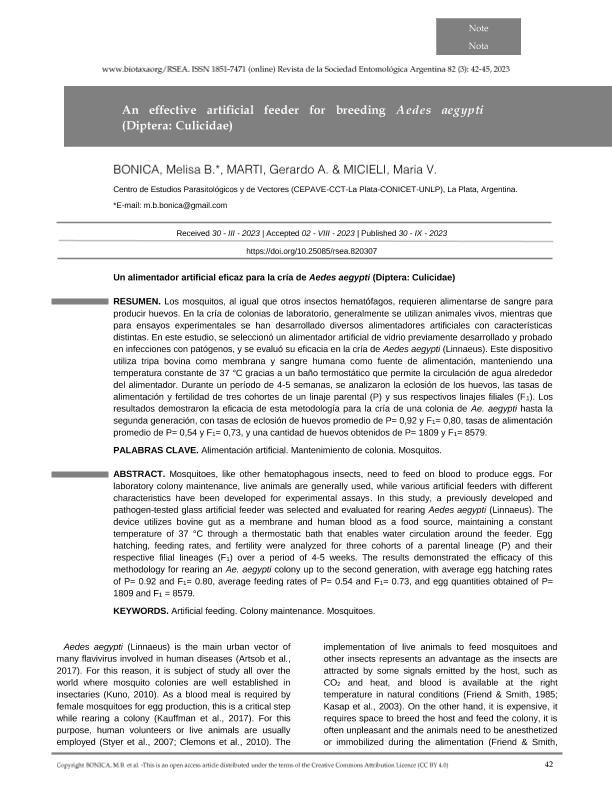Mostrar el registro sencillo del ítem
dc.contributor.author
Bonica, Melisa Berenice

dc.contributor.author
Marti, Gerardo Anibal

dc.contributor.author
Micieli, Maria Victoria

dc.date.available
2024-02-16T13:20:07Z
dc.date.issued
2023-09
dc.identifier.citation
Bonica, Melisa Berenice; Marti, Gerardo Anibal; Micieli, Maria Victoria; An effective artificial feeder for breeding Aedes aegypti (Diptera: Culicidae); Sociedad Entomológica Argentina; Revista de la Sociedad Entomológica Argentina; 82; 3; 9-2023; 42-45
dc.identifier.issn
0373-5680
dc.identifier.uri
http://hdl.handle.net/11336/227192
dc.description.abstract
Mosquitoes, like other hematophagous insects, need to feed on blood to produce eggs. For laboratory colony maintenance, live animals are generally used, while various artificial feeders with different characteristics have been developed for experimental assays. In this study, a previously developed and pathogen-tested glass artificial feeder was selected and evaluated for rearing Aedes aegypti (Linnaeus). The device utilizes bovine gut as a membrane and human blood as a food source, maintaining a constant temperature of 37 °C through a thermostatic bath that enables water circulation around the feeder. Egg hatching, feeding rates, and fertility were analyzed for three cohorts of a parental lineage (P) and their respective filial lineages (F1) over a period of 4-5 weeks. The results demonstrated the efficacy of this methodology for rearing an Ae. aegypti colony up to the second generation, with average egg hatching rates of P= 0.92 and F1= 0.80, average feeding rates of P= 0.54 and F1= 0.73, and egg quantities obtained of P= 1809 and F1 = 8579.
dc.description.abstract
Mosquitoes, like other hematophagous insects, need to feed on blood to produce eggs. For laboratory colony maintenance, live animals are generally used, while various artificial feeders with different characteristics have been developed for experimental assays. In this study, a previously developed and pathogen-tested glass artificial feeder was selected and evaluated for rearing Aedes aegypti (Linnaeus). The device utilizes bovine gut as a membrane and human blood as a food source, maintaining a constant temperature of 37 °C through a thermostatic bath that enables water circulation around the feeder. Egg hatching, feeding rates, and fertility were analyzed for three cohorts of a parental lineage (P) and their respective filial lineages (F1) over a period of 4-5 weeks. The results demonstrated the efficacy of this methodology for rearing an Ae. aegypti colony up to the second generation, with average egg hatching rates of P= 0.92 and F1= 0.80, average feeding rates of P= 0.54 and F1= 0.73, and egg quantities obtained of P= 1809 and F1 = 8579.
dc.format
application/pdf
dc.language.iso
eng
dc.publisher
Sociedad Entomológica Argentina

dc.rights
info:eu-repo/semantics/openAccess
dc.rights.uri
https://creativecommons.org/licenses/by/2.5/ar/
dc.subject
ARTIFICIAL FEEDING
dc.subject
cCOLONY MAINTENANCE
dc.subject
MOSQUITOES
dc.subject.classification
Zoología, Ornitología, Entomología, Etología

dc.subject.classification
Ciencias Biológicas

dc.subject.classification
CIENCIAS NATURALES Y EXACTAS

dc.title
An effective artificial feeder for breeding Aedes aegypti (Diptera: Culicidae)
dc.title
Un alimentador artificial eficaz para la cría de Aedes aegypti (Diptera: Culicidae)
dc.type
info:eu-repo/semantics/article
dc.type
info:ar-repo/semantics/artículo
dc.type
info:eu-repo/semantics/publishedVersion
dc.date.updated
2024-02-15T13:44:41Z
dc.journal.volume
82
dc.journal.number
3
dc.journal.pagination
42-45
dc.journal.pais
Argentina

dc.journal.ciudad
Mendoza
dc.description.fil
Fil: Bonica, Melisa Berenice. Consejo Nacional de Investigaciones Científicas y Técnicas. Centro Científico Tecnológico Conicet - La Plata. Centro de Estudios Parasitológicos y de Vectores. Universidad Nacional de La Plata. Facultad de Ciencias Naturales y Museo. Centro de Estudios Parasitológicos y de Vectores; Argentina
dc.description.fil
Fil: Marti, Gerardo Anibal. Consejo Nacional de Investigaciones Científicas y Técnicas. Centro Científico Tecnológico Conicet - La Plata. Centro de Estudios Parasitológicos y de Vectores. Universidad Nacional de La Plata. Facultad de Ciencias Naturales y Museo. Centro de Estudios Parasitológicos y de Vectores; Argentina
dc.description.fil
Fil: Micieli, Maria Victoria. Consejo Nacional de Investigaciones Científicas y Técnicas. Centro Científico Tecnológico Conicet - La Plata. Centro de Estudios Parasitológicos y de Vectores. Universidad Nacional de La Plata. Facultad de Ciencias Naturales y Museo. Centro de Estudios Parasitológicos y de Vectores; Argentina
dc.journal.title
Revista de la Sociedad Entomológica Argentina

dc.relation.alternativeid
info:eu-repo/semantics/altIdentifier/url/https://www.biotaxa.org/RSEA/article/view/81193
Archivos asociados
